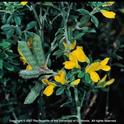Seeing yellow these days? As in…those brightly-blooming yellow-flowering shrubs along roads and hillsides from the Bay Area to the Sierra Nevada foothills. Broom—French, Spanish, and Scotch—is in full spring bloom, even at higher elevations.
Spanish broom, Spartium junceum (also known as Genista juncea), is a heat-loving, deciduous, flowering shrub with yellow, pea-like flowers in the family Fabaceae. Originally used as a landscape shrub, it has escaped into wild lands and occupies disturbed sites along roadsides in warm, sandy soil. It can establish dense stands and out-compete native vegetation.
Like Spanish broom, French broom, Genista monspessulana, is also native to Mediterranean regions and becomes invasive when introduced into other Mediterranean climates such as the western coast of the US and South America. French broom, unlike Spanish broom, is an evergreen shrub.
Scotch broom, Cytisus scoparius, is a deciduous shrub native to northern and central Europe that behaves similarly to French and Spanish brooms. All of the invasive brooms form seed pods that explode audibly, forcibly ejecting seeds from the pod, flinging them some distance from the mother plant.
A new “safe” broom on the home horticulture scene, Sweet Broom, Genista spa chiana, is advertised as sterile and non-invasive and is widely available for spring planting from local nurseries and big-box garden centers. However, research performed at UC Davis has found DNA evidence showing that sweet broom hybridizes with French broom.
chiana, is advertised as sterile and non-invasive and is widely available for spring planting from local nurseries and big-box garden centers. However, research performed at UC Davis has found DNA evidence showing that sweet broom hybridizes with French broom.
UC Cooperative Extension Central Sierra staff from Amador and Tuolumne Counties is working with the California Invasive Plant Council (Cal-IPC) on a broom removal planning project funded by a grant from the Sierra Nevada Conservancy.
In 2012, Cal-IPC submitted an application to the Sierra Nevada Conservancy for a planning grant targeting two noxious weeds in two locations—broom along California State Highway 120’s Priest Grade in the Groveland area of Tuolumne County and Dyer’s woad in Plumas County. The grant application was successfully funded. The purpose of a planning grant is to provide population mapping of noxious weed locations, to prepare plans for the removal project and to secure environmental permits for work to be performed.
In Tuolumne County, this translates into plans to remove broom along several sections of California State Highway 120 leading toward Yosemite National Park. Broom is located on private land, state right-of-way easements and on federally managed lands.
On January 28, a team of local experts, consisting of staff from the Tuolumne County Agriculture Department, U.S. Forest Service, California-IPC, and UCCE Central Sierra spent the day mapping broom—Spanish and French—along side roads and main highways in the Groveland, California area. In March, another day was spent completing the mapping segment of the project.
In the near future, collaboration among agencies under the oversight of Cal-IPC will, hopefully, have you seeing less yellow along the roadsides.
Attached Images:
